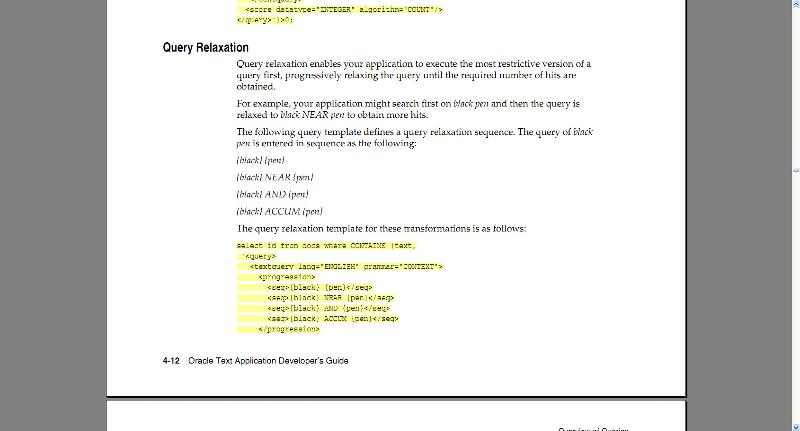mjfigur
asked on
Query Progression PL/SQL Syntax
I cannot thank everyone enough for their help and I promise the last question I should have on this project. The issue is just that I am learning PL/SQL and my ablity to understand the syntax is still very undeveloped.
I have the following PL/SQL which is currently working well:
I would like to add:
<seq>(NEAR((:p1_search_str
however whenever I try and add that into the <query> portion of the code I recieve errors stating that NEAR is not defined. For some reason I just cannot get the syntax correct.
Below is an example of what the code looks like in SQL and works for the below example:
I have the following PL/SQL which is currently working well:
DECLARE
v_query VARCHAR2 (4000);
v_search_string VARCHAR2(4000);
BEGIN
v_query := 'SELECT ';
v_search_string := '<query>
<textquery>
<progression>
<seq>'||:p1_search_string||'</seq>
<seq>'||replace(:p1_search_string,' ',' $')||'</seq>
<seq>'||replace(:p1_search_string,' ',' ?')||'</seq>
</progression>
</textquery>
</query>';
IF :p1_search_string IS NOT NULL
THEN
v_query := v_query || 'score (1) relevance, ';
ELSE
v_query := v_query || '''100%'' relevance, ';
END IF;
v_query :=
v_query || 'SUBSTR (website, INSTR (website, ''/'') + 1) '
|| 'document,' || 'ID, ';
IF :p1_search_string IS NOT NULL
THEN
v_query :=
v_query
|| 'NVL2 '
|| '(:p1_search_string, '
|| 'ctx_doc.snippet '
|| '(''docsx'', '
|| 'ROWID, '
|| 'NVL (:p1_search_string, ''%''), '
|| '''<span style="color:darkgreen;'
|| 'font-weight:bold;font-size:14px;">'', '
|| '''</span>'' '
|| '), '
|| 'NULL '
|| ') snippet ';
ELSE
v_query := v_query || 'NULL snippet ';
END IF;
v_query := v_query || 'FROM docs ';
IF :p1_search_string IS NOT NULL
THEN
v_query :=
v_query
|| 'WHERE contains (document, ''' || v_search_string || ''', 1) > 0';
END IF;
v_query := v_query || 'ORDER BY 1 DESC ';
RETURN (v_query);
END;I would like to add:
<seq>(NEAR((:p1_search_str
however whenever I try and add that into the <query> portion of the code I recieve errors stating that NEAR is not defined. For some reason I just cannot get the syntax correct.
Below is an example of what the code looks like in SQL and works for the below example:
select SCORE(1),website, document from docs WHERE CONTAINS(document,
'<query>
<textquery>
<progression>
<seq>(borrower solicitation) </seq>
<seq>($borrower $solicitation) </seq>
<seq>(NEAR((borrower,solicitation),15,TRUE)) </seq>
<seq>(NEAR(($borrower,$solicitation),15,TRUE)) </seq>
<seq>(borrower% solicitation%) </seq>
<seq>(FUZZY(borrower,,,WEIGHT) FUZZY(solicitation,,,WEIGHT))</seq>
</progression>
</textquery>
<score datatype="INTEGER" algorithm="COUNT"/>
</query>', 1)>0
Order by SCORE(1) descASKER
But that doesn't show the normal 'contains' use of near where you can specify word proximity and preserve order.
ASKER
Right good point did not catch that one. I might have to reach out to Oracle Support on that one or dig deeper into the documentation.
ASKER CERTIFIED SOLUTION
membership
This solution is only available to members.
To access this solution, you must be a member of Experts Exchange.
lol... should have just tried it.
NEAR syntax is allowed. The error must be elsewhere.
I tested the below code in 10.2.0.3 and 11.2.0.2
NEAR syntax is allowed. The error must be elsewhere.
I tested the below code in 10.2.0.3 and 11.2.0.2
drop table tab1 purge;
create table tab1(col1 varchar2(50));
insert into tab1 values('Fred Flintstone');
insert into tab1 values('Barney Rubble');
commit;
create index tab1_idx on tab1(col1) indextype is ctxsys.context;
select col1 from tab1 where contains(col1,'
<query>
<textquery>
<progression>
<seq>(fred flintstone) </seq>
<seq>($fred $flintstone) </seq>
<seq>(NEAR((fred,flintstone),15,TRUE)) </seq>
<seq>(NEAR(($fred,$flintstone),15,TRUE)) </seq>
<seq>(fred% flintstone%) </seq>
<seq>(FUZZY(fred,,,WEIGHT) FUZZY(flintstone,,,WEIGHT))</seq>
</progression>
</textquery>
</query>') > 0;ASKER
That is great to hear and should be a major help with search queries! What would the syntax of the NEAR statement be in PL/SQL? Would it be a situation where I would need to find the variable or concatenate. Just always have an issue of getting my apostrophes in the right area.
>What would the syntax of the NEAR statement be in PL/SQL?
Should be the same.
>>Would it be a situation where I would need to find the variable or concatenate
The answer to this is: It depends. You will likely need to dynamically build the string like you have started doing. I had to...
With the template example I mentioned in http:#a35466692 it should get a lot simpler.
>>Just always have an issue of getting my apostrophes in the right area.
Just remember: Use two to get one!
Should be the same.
>>Would it be a situation where I would need to find the variable or concatenate
The answer to this is: It depends. You will likely need to dynamically build the string like you have started doing. I had to...
With the template example I mentioned in http:#a35466692 it should get a lot simpler.
>>Just always have an issue of getting my apostrophes in the right area.
Just remember: Use two to get one!
ASKER
Thank you so much it appears that the transform is much easier to use than relaxation as you have to use explicit replace functions in the relaxation method. Thanks again.
Glad to help!
Besides, from your previous question: Progression is new to me so I'm learning as well!
Besides, from your previous question: Progression is new to me so I'm learning as well!

As you know by your previous question, I just learned about progressive regression but I doubt the NEAR function is compatible.
Text doesn't like to mix and match features. Does the docs suggest you can use near?
You might want to ask Oracle Support on this one.